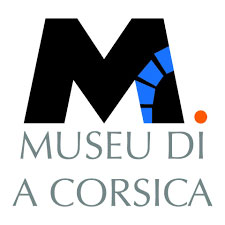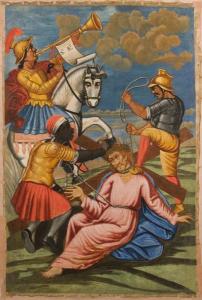The Sepulchre of San Damiano restored and then presented at the Palazzo Ducale in Genoa from May 11 to August 25, 2013.
The decorations of Holy Week, whose production developed throughout the western Mediterranean arc between the seventeenth and nineteenth centuries, form a set now widely documented, mainly at the initiative of the Soprintendenza per i beni storici, artistici ednoantropologici della Liguria, based in Genoa. The materials and techniques used for their realization are very diverse depending on the context. Commonly named cartelami in Liguria, because of the use of cardboard for their realization, these ephemeral decorations are generally made in Corsica from more durable materials.
This is the case with the sepulchre of San Damiano, composed of panels of painted canvas mounted on a frame, all assembled on a wooden structure, to form a practicable pavilion to be mounted in a side chapel of the church. This is how one enters the oratory to contemplate the scenes of the Passion. This sepulchre is dated 1751, and would have been made by the painter Giacomo Grandi, originally from Milan, whose activity in Corsica is attested from 1742.
It was a few years ago in an advanced state of degradation, preserved along with countless decorations in more than precarious conditions. The loss of use of these heritage assets had indeed led during the twentieth century to their oblivion and gradual abandonment. Fully restored in 2005, the sepulchre of San Damiano was presented to the public in 2010 at the Museum of Corsica on the occasion of the exhibition The Brotherhoods of Corsica. It has been kept since then in the museum’s reserves pending the restoration of the church in the town of San Damiano. This building in fact, because of its condition, is not able to offer its sepulchre favorable conditions for its conservation in good conditions.
The Palazzo Ducale of Genoa wanted the presentation of this work on the occasion of its exhibition Il gran teatro dei Cartelami. The 2005 restoration had involved extensive interventions, especially on the most degraded panels. These very fragile parts had minimal lifting of the pictorial layer and required curative conservation interventions before leaving for exhibition. These refixings and retouchings were carried out by painting restorer Philippe Lenzini.
Le tratteggio
The technique of cross-hatching, or tratteggio, widely used on the sepulchre of San Damiano in 2005, was developed to solve the problem of restoring paintings that were too badly degraded and therefore too incomplete. Leaving the work incomplete in fact makes them difficult to read; conversely, a complete restoration implies in a sense a falsification of the work, since the original parts are no longer distinguished from the reconstruction. Thus the tratteggio allows to solve this dilemma, by implementing retouching in parallel vertical hatching in harmony with the original image.
Removements and refixing
Lifting of the paint layer most often occurs as a result of climatic variation, leading to movement of the paint support. In the case of the sepulchre of San Damiano, the canvas had resorbed and, being softer than the pictorial material, had generated breaks on the latter. The refixing implemented by Philippe Lenzini consisted in bringing an adhesive, in this case skin glue, allowing to restore the cohesion of the whole.




